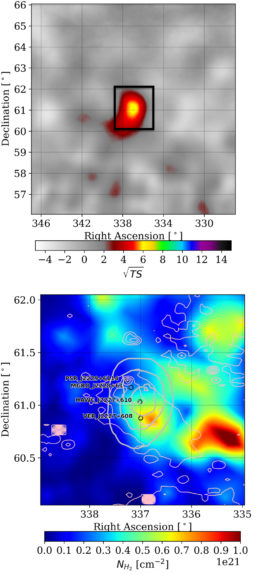Speeding charged particles — far more energetic than any we can create in laboratory particle accelerators — constantly bombard the Earth’s atmosphere. But what extreme environments produce these high-energy particles? A new study may have identified one cosmic accelerator in our galaxy.

Diagram showing cosmic ray flux as a function of energy. The lower-energy cosmic rays (yellow region) are thought to be produced by the Sun. Intermediate-energy cosmic rays (blue region) are likely of galactic origin, and the highest-energy cosmic rays (pink region) likely come from beyond the galaxy. [Sven Lafebre]
Charged Arrivals
At any given moment, protons and atomic nuclei are whizzing through our galaxy, sometimes at nearly the speed of light. These charged particles — cosmic rays —span a wide range of energies, with the most energetic packing the same punch as a 90 kilometer-per-hour (56 mph) baseball!
More modest cosmic rays reach “only” peta-electron-volt (PeV) energies — that’s 1015 eV, still more than 100 times more energetic than the particles accelerated by the record-holding Large Hadron Collider. We think that these PeV particles were produced somewhere within our own galaxy.
If we could unravel their secrets, these cosmic rays could provide clues about how stars evolve and how energy is transported throughout the galaxy. First, however, we need to figure out where they came from. Are their sources supernova remnants? Microquasars? Superbubbles? What galactic PeVatrons accelerated these particles to their tremendous speeds?

Cosmic rays (red) consist of individual protons and nuclei of heavier elements. They are deflected by magnetic fields along their cosmological odysseys and can’t be used to point back to the place of their origin. Click to enlarge diagram. [IceCube Neutrino Observatory]
Road Map to a Birthplace
Unfortunately, we can’t just trace cosmic rays backwards to figure out their origins. Because these particles are charged, their trajectories are deflected by interstellar magnetic fields — which means that the direction a cosmic ray arrived from probably isn’t the direction of its source.
To address this challenge, high-energy astronomers search for more direct messengers that are produced as cosmic rays are accelerated — like extremely energetic gamma-ray radiation.
When PeV particles accelerated by a galactic PeVatron collide with gas and dust in the vicinity of their origin, they should produce very high-energy tera-electron-volt (TeV, or 1012 eV) gamma-ray photons. These photon by-products won’t be deflected by magnetic fields, so their arrival at gamma-ray observatories on Earth provides a clearer path back to the source of the PeV cosmic rays.

Top: significance map from HAWC showing the location of gamma-ray emission from near SNR G106.3+2.7. Bottom: Molecular hydrogen column density around the HAWC-detected source (shown in gray contours). The detectors VERITAS and Milagro have also observed very high-energy gamma-ray emission from this region; their detection centers are also marked. [Adapted from Albert et al. 2020]
Hunting for Galactic Accelerators
So how’s the search for these characteristic TeV gamma-rays going? With one possible success on the books so far — scientists think there’s a galactic PeVatron at the center of our galaxy, but we haven’t yet determined the source — we’ve now identified a new potential galactic PeVatron: the remnant produced by a past supernova explosion just 2,600 light-years from Earth.
In a new publication, a team of scientists from the High-Altitude Water Cherenkov Gamma-Ray Observatory (HAWC) announces the detection of TeV gamma-ray emission from the same region as supernova remnant SNR G106.3+2.7.
Though the team can’t rule out other causes of the emission, this signal has a spectrum that’s consistent with what we’d expect to be produced by PeV protons colliding with gas and dust. The origin near SNR G106.3+2.7 supports a picture in which charged particles can be accelerated across the shocks of supernova remnants and flung into space with PeV energies.
So might the mystery of galactic PeVatrons be solved with supernova remnants? We don’t know for sure yet, but future high-energy gamma-ray observations are sure to help us further identify the sources of the speeding charged particles in our galaxy.
Citation
“HAWC J2227+610 and Its Association with G106.3+2.7, a New Potential Galactic PeVatron,” A. Albert et al 2020 ApJL 896 L29. doi:10.3847/2041-8213/ab96cc

1 Comment
Pingback: From AAS NOVA: “Spotted: A Galactic PeVatron?” | sciencesprings